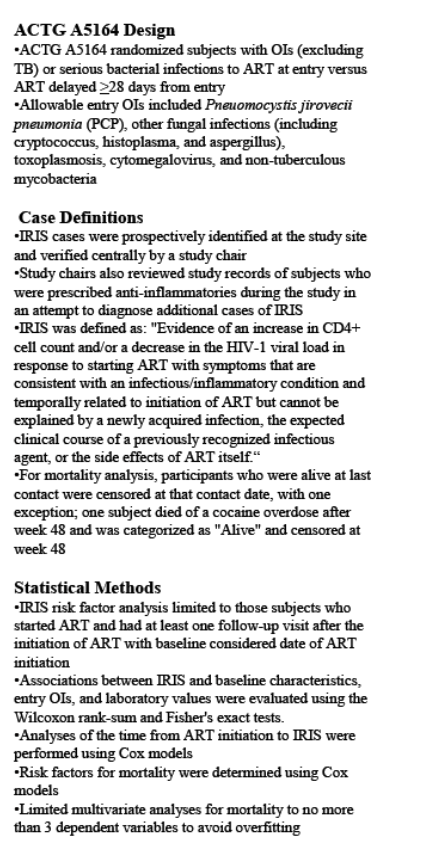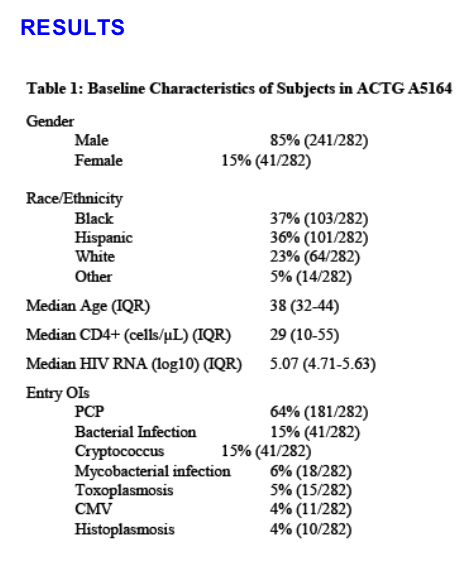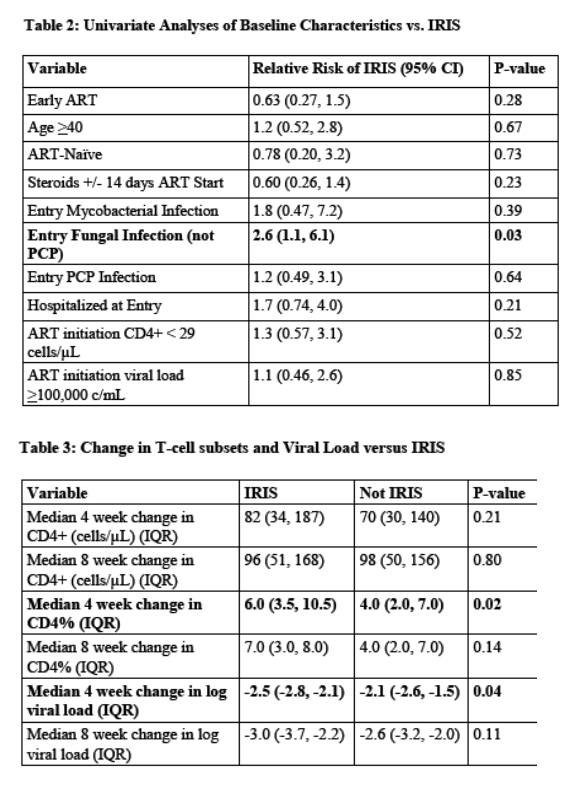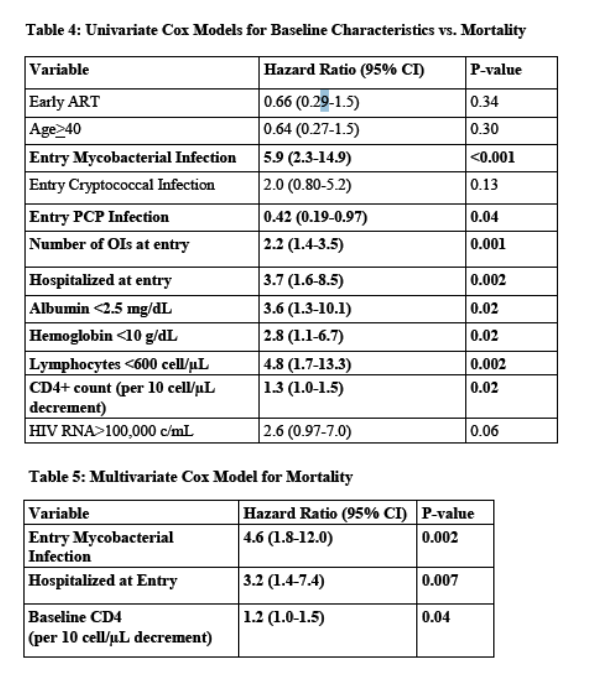 |
 |
 |
| |
Risk Factor Analyses for Immune Reconstitution Inflammatory Syndrome and Mortality during a Randomized Trial of Early versus Deferred ART in the Setting of Acute Opportunistic Infections (ACTG A5164)
|
| |
| |
Reported by Jules Levin
CROI 2009 Montreal Feb 8-12
Philip Grant1, Lauren Komarow2, Irini Sereti3, Savita Pahwa4, Michael Lederman5, William Powderly6, Fred Sattler7, Paul Sax2, Janet Andersen2, Andrew Zolopa1
1Stanford University, Palo Alto, CA, 2Harvard University, Boston, MA, 3 NIH, Bethesda, MD, 4 University of Miami, Miami, FL, 5 Case Western University, Cleveland, OH, 6 University College Dublin, Dublin, IE, 7 University of Southern California, Los Angeles CA
"Change in viral load and change in CD4% at 4 weeks are both clearer predictors of IRIS than change in CD4+ count"
AUTHOR CONCLUSIONS
IRIS Secondary Analysis
Retrospective reports likely overestimate the incidence of IRIS
The 7.6% incidence of IRIS in this study is similar to the 10.4% estimate from a large prospective cohort from South Africa (Murdoch, et al)
In patients with an acute OI, it is difficult to predict who will develop IRIS from baseline characteristics, although those with fungal disease (other than PCP) may be at increased risk of IRIS.
Corticosteroids, as used in this study, do not appear to prevent IRIS but may delay its presentation
Change in viral load and change in CD4% at 4 weeks are both clearer predictors of IRIS than change in CD4+ count
In subjects with non-TB OIs, early initiation of ART does not increase the incidence of IRIS, and concern for IRIS should not be a reason to defer ART
The previous association found in retrospective studies between early ART initiation and IRIS may have been due to biases inherent in their study designs
Mortality Secondary Analysis
Risk factors for increased mortality in the pre-ART era including low albumin, hemoglobin, total lymphocytes and CD4+ count remain important predictors in patients with an acute OI initiating ART
CD4+ counts obtained at baseline during an acute OI should not be discounted as they predict survival, with lower values associated with an increased risk of death
Mycobacterial infections are associated with high rates of mortality despite ART
ABSTRACT
Background
Immune Reconstitution Inflammatory Syndrome (IRIS) complicates ART initiation in 10- 40% of patients. Despite ART, patients with advanced HIV remain at increased risk for mortality. Few prospective studies have evaluated risk factors for IRIS and mortality in this setting.
Methods
A5164 randomized subjects with OIs (excluding TB) to ART at entry (E-ART) vs. ART delayed ≥28 days from entry (D-ART). Associations between IRIS and baseline characteristics, entry OIs, and laboratory values were evaluated using Wilcoxon and Fisher's tests. Multivariate analyses of the time from ART initiation to IRIS were performed using Cox models with time-varying covariates. Risk factors for mortality were determined using Cox models.
Results
Of 282 subjects (median CD4 29 cells/μL, HIV viral load (VL) 5.1 log c/mL) enrolled, 262 initiated ART. 23/282 (8.2%) died. 20/262 (7.6%; 95% CI: 4.7%, 11.5%) developed IRIS after a median of 33 days (IQR 26, 72) on ART, 8/135 on E-ART and 12/127 on D- ART (p=0.35). No baseline variables were associated with IRIS. There was no difference in IRIS between subjects who received corticosteroids during their OI and those who did not - 9/150 (6.0%) vs. 11/112 (9.8%), p=0.35. However, no subjects developed IRIS while still receiving corticosteroids. Log VL decline at 4 weeks was associated with IRIS (-2.48 vs. -2.07, p=0.04) but change in CD4 was not. In Cox models controlling for VL change, subjects with fungal infections had a hazard ratio (HR) of 2.9 for developing IRIS (p=0.02). In univariate analyses, entry mycobacterial infections (HR=5.9, p<0.01), OI number (HR=2.2 for each additional OI, p<0.01), hospitalization (HR=3.7, p<0.01), low albumin (HR=3.6, p=0.02), low hemoglobin (HR=2.8, p=0.03), and low CD4 (HR=1.3 for each 10 cells/μL decrement, p=0.02) were associated with mortality. In multivariate analysis, entry mycobacterial infection (HR=4.6, p<0.01), hospitalization (HR=3.2, p<0.01), and low CD4 (HR=1.2 for each 10 cells/μL decrement, p=0.04) predicted mortality.
Conclusion
Predicting who will develop IRIS at ART initiation is difficult. E-ART does not lead to an increase in IRIS in non-TB OI. Change in VL, but not CD4, predicted IRIS. Corticosteroids, as used in this study, do not appear to prevent IRIS but may delay its presentation. Risk factors for increased mortality in the pre-ART era including low albumin, hemoglobin and CD4 remain important in patients with an OI initiating ART. Mycobacterial infections are associated with high rates of mortality despite ART.
BACKGROUND
Reported prevalence of IRIS ranges from 10-40%
Majority of studies are retrospective and include patients without OIs at baseline
Two retrospective studies have shown an association between "early" ART and IRIS but confounders such as adherence may have biased results
ART is sometimes deferred in patients with an acute OI because of fear of IRIS, despite the limitations of the data
Patients with acute OI initiating ART remain at significant risk for mortality
Few prospective studies evaluate the risk factors for IRIS and mortality
Primary study, ACTG A5164 presented at CROI 2008 (Zolopa, et al; abstract#142) showed decreased AIDS progression/death with early ART in acute OI (14% vs 24%; p=0.04)
METHODS




|
| |
|
 |
 |
|
|